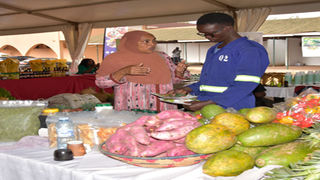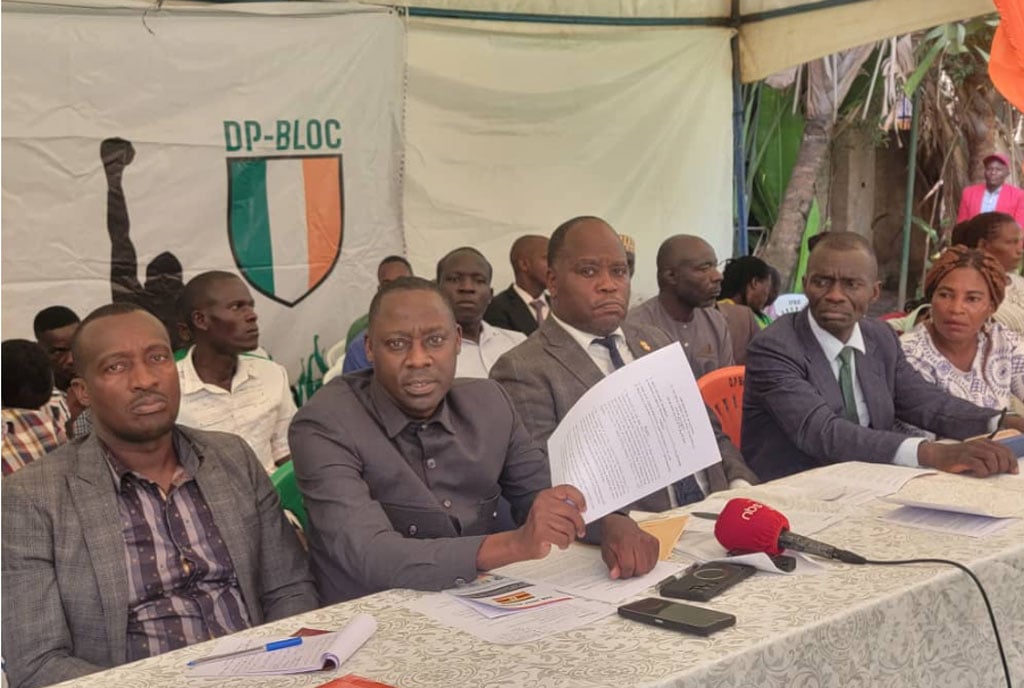
A woman chats with an organic food exhibitor. Uganda is only responsible for less than 5 percent of global organic food exports. PHOTO/ Aloysious Atwine
|From farm to global table: Making organic farming money
What you need to know:
As consumers turn to healthier food portions, there is a growing demand for organic food both locally and globally. While the market for organic food is growing, farmers can form groups to meet one major requirement - certification.
Since the year 2000, global production and trade in organic agriculture has expanded 10-fold, industry players say the sector is currently estimated by FiBl/IFOAM (2023) to hit $130 billion by 2026.
The shift to organic reflects a post-pandemic and climate challenged era, based on changing consumer preferences for hazard free food and greater consciousness of the importance of conserving the environment.
Organic farming involves raising crops and livestock without synthetic herbicides, pesticides, fertilisers and hormones. The farms also are prohibited from using genetically modified seeds.

A man arranges irish potatoes in Kalerwe market. PHOTO/ Michael Kakumirizi
Farmers rely on natural processes (eco-friendly farming techniques), compost manure and biological pest control methods to boost soil fertility or manage pests and diseases.
The sad part is that Uganda is only responsible for less than 5 percent of global organic food exports at a time when unmet demand in the European Union (EU) alone is estimated to be 500 million euros.
Moreover, domestically, there is a growing preference among consumers for organic products as more consumers become conscious of their lifestyle choices and demand healthy foods. This probably explains the mushrooming number of organic shops and supermarkets in Uganda, with retail organic products, some of which are imported.
Cheaper option
Mr Chariton Namuwoza, the chief executive officer, National Organic Agricultural Movement of Uganda (NOGAMU), says organic agriculture is economically viable, and meets the requirements of food safety, food security and food nutrition.
“Farmers can engage in organic farming and make money; a farmer needs less costly inputs compared to expensive conventional inputs, they can make their own fertilisers by compositing and if they can’t, buy at cheap price manufactured organic inputs,” he explains.
Things like pesticides, fertilisers, vermicides and animal drugs, supplements to increase milk production, animal weight, and fish can be made organically without using synthetics.
“The more farmers produce, the more they earn; for instance, for an acre, a farmer will need a set of inputs and when you put together the cost of the inputs versus what a conventional farmer uses, it costs an organic farmer less to get the same output,” he said.
He adds; “For an organic farmer you will need about Shs150,000 for inputs per acre but for inorganic farming, it will cost one more than Shs250,000 per acre for input, which leaves a farmer with more money saved from inputs alone.”
Mr Namuwoza explains that in the last three years, prices of inorganic fertilisers and other inputs like pesticides and herbicides have gone up. An organic farmer needs about 50 per cent less compared to a conventional farmer.
When the costs of doing business are high, the profitability also drops. Mr Namuwoza further explains that in coffee farming, both the organic farmer and inorganic farmer will get the same quantities.
The business of organic farming has its special chain; for one to be an organic farmer, all inputs or most of them including the fertilisers, pesticides, crop and animal supplements should be organic.
Market
Most common organic food exports are vegetables, such as tomatoes, green beans, okra, cabbages, African garden egg plants, water spinach, pumpkins, cucumber, banana, and pepper grown all around the country with support of good climatic conditions.
With such kind in Uganda, this is an indication of how important organic farming and export of organic products is becoming. Government policy makers and NOGAMU say there is demand on the local, regional and international market.

An exhibitor explains organic products to a customer. PHOTO/JUSTUS LYATUU
NOGAMU says that although in Uganda the prices of organic and conventional foods are almost similar, international businesses fetch better prices.
“We have supermarkets, farm markets, shop are mushrooming labelled, hotels and restaurants in Uganda; we also have Kenya, Rwanda, and South Sudan then we have EU who are interested in coffee, fruits and vegetables, spices, juices, cocoa, herbal teas, chilli, ginger; oil crops like Sim sim and sunflower,” Mr Namuwoza explains.
He adds; “We have a big component of farmers targeting the international market but there is a drive to promote local consumption by having exhibitions. We invite the public to go organic.”
According to Mr Alex Lukwago, the managing director at Balimisa Uganda, the market for organic commodities is always available as long as one a trader is able to meet the certification process.
“We have a big market that we can’t even meet; we deal in dried pineapple, dried jackfruits, vanilla and other commodities right now. We have a big market in DRC and South Sudan, and now we are looking at Somalia” he says.
Started in 2021, Balimisa farms are located in Kayunga district and works with over 100 organic farmers around the district.
Mr Shadrack Namunyu, an agronomist with S.R Organic explains that there is not only high demand for organic foods but for organic inputs.
He says that since his company started organic farm input production, there has been demand for more both locally and on the regional market.
“The demand is high, what has pushed it is the fact that people used to think that when talking of inputs like fertilisers, the question that arose was that it was bulky and labour intensive.
“Pricewise it’s cheap; for instance a kilogramme of organic fertiliser goes for Shs50,000 and if you compare with synthetic fertilisers, organic is cheap,” Mr Namunyu explains.
“That is just a local price, but when we export our products, sometimes the prices even double; regional and international markets appreciate organic foods than local markets,” he said.
Certification
There are two types of certification; the third party certification that targets the international markets like European Union (EU), USA, Japan, China among others; this certification is expensive and excludes most of the farmers in Uganda.
“What usually helps farmers is when they work in groups to attain the certification and in this case the buyer foots the bills of certification,” he says.
The second form of certification acceptable is the participatory guarantee system; the participation of different stakeholders including farmers, extension officers, local leaders and buyers who come together to verify the practices of the farmers.
“On the basis of their observations, the farmer, farmer group or association are given a go ahead to attain certification and NOGAMU is mandated to ratify the decisions of the stakeholders. Nogamu also does spot checks and offers certificates,” he says.
Mr Namuwoza adds, “Our certificates are recognised in the local markets, regional markets of the East African.”
Also in the regional organic market, farmers use Kilimo Hai mark; this is the certification mark that Nogamu is trying to rollout in Uganda. It is believed that the Kilimo Hai mark comes at a much lower cost; it costs roughly Shs5,000.
On how to get the Kilimo Hai mark Mr Nawoza says the first step is the farmer must understand the standard they are attaining; acceptable organic standards and unacceptable organic standards.
“For instance when you are on the farm standards are built on four principle which include; ecology health, care and fairness- apply, compost, don’t burn, don’t litter plastics in your farm, put buffers, don’t apply synthetics, how you label, how you process ” he explains.
The next stage is putting into process, this requires organization; someone doing quality control, marketing, transport, production should be different.
Periodic reviews are also done; according to Mr Namuwoza, farmers come together periodically and review each other through knowledge and experience sharing, bringing in experts to help them.
And for the third party certification, it follows the internal control system which is documented; there are four parts- part one looks at the actors- people responsible for handling the products, part two explains the roles of personnel.
The third part is documentation and evidence to show that what you are doing is organic.
“This system mirrors the court; the only way you can prove is having documented evidence or having witnesses but whatever you claim must be backed by documentation to help in traceability,” he said.
Mr Namuwoza says, “What inputs are you using? How are you managing the farm? How do you manage soil erosion and water supply to the plant? How do you guard against contamination from neighbours who are using synthetic material? All these must be documented.”
A farmer will also need traceability evidence material like good received notes, invoices, packing lists all these must be evidenced by documents.
There are also internal inspectors who conduct internal audits. When they finish, external auditors check and write a report that informs whether one will be offered certification or not.”
“Third party certification for EU and other markets costs between $5,000 (Shs18.8 million)- $20,000 (Shs73 million) per system; the whole process covers right from the seed through the value chain to the market, this is usually done in groups” he explains.
He adds, “For the third party certification, we discourage individual certification; smallholder farmers cannot afford certification individually. So, we encourage them to form groups.”
Mr Namuwoza illustrates that the $5,000 (Shs18.8 million) to $20,000 (Shs73 million) include costs of preparing for the certification.
“For 15 farmers, it will cost $3,000 (Shs11 million), the cost of preparing certification is also the same so if you double you reach a figure of $6,000 (Shs22.6 million) per group and if they are more, the price keeps increasing.”
Both Kilimo hai and Third party certification are valid for one year but renewable when a farmer meets the conditions.
According to Mr Lukwago, although certification is important, is very costly especially for small and medium farmers and traders.
“Certification is a hindrance to foreign trade, clients ask for certification,” he says.
Some of the regional certificates needed include- fair trade certification, there are also environment certifications that ensure that farmers are not tampering with nature and the organic farming certificate.
Mr Namuwoza adds, “To get to international markets, we have to verify; the process of certification looks at how one packages, the processing, and tests both internal and external and registrations with the Ministry of Agriculture,” he said.




